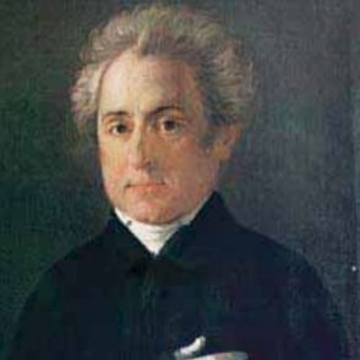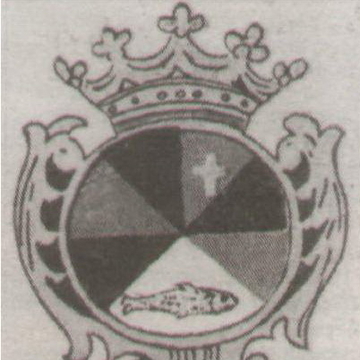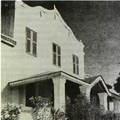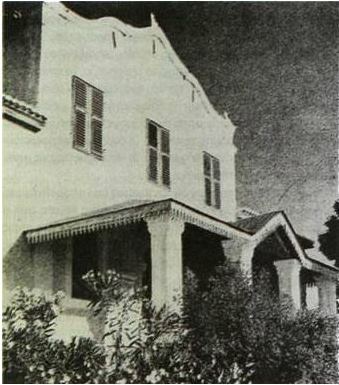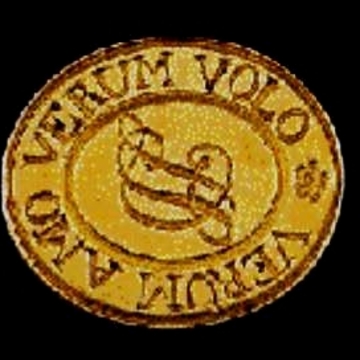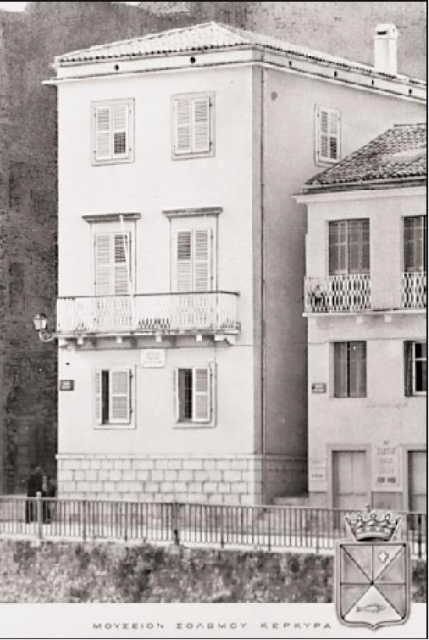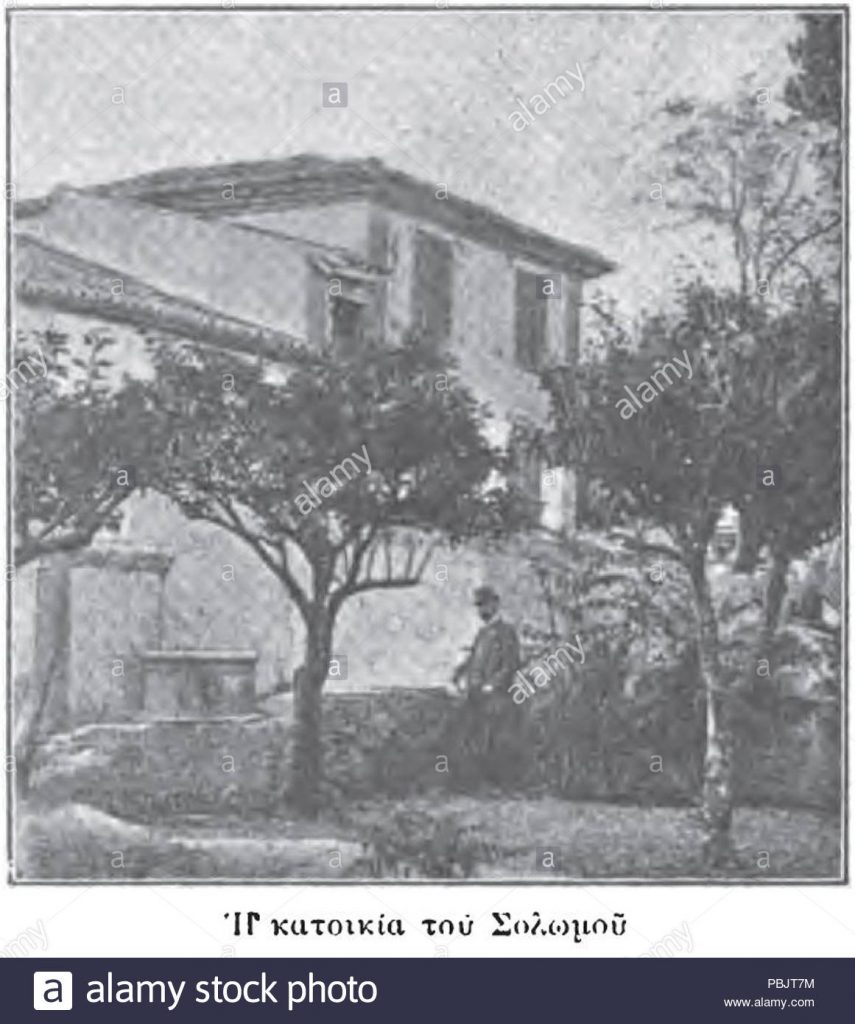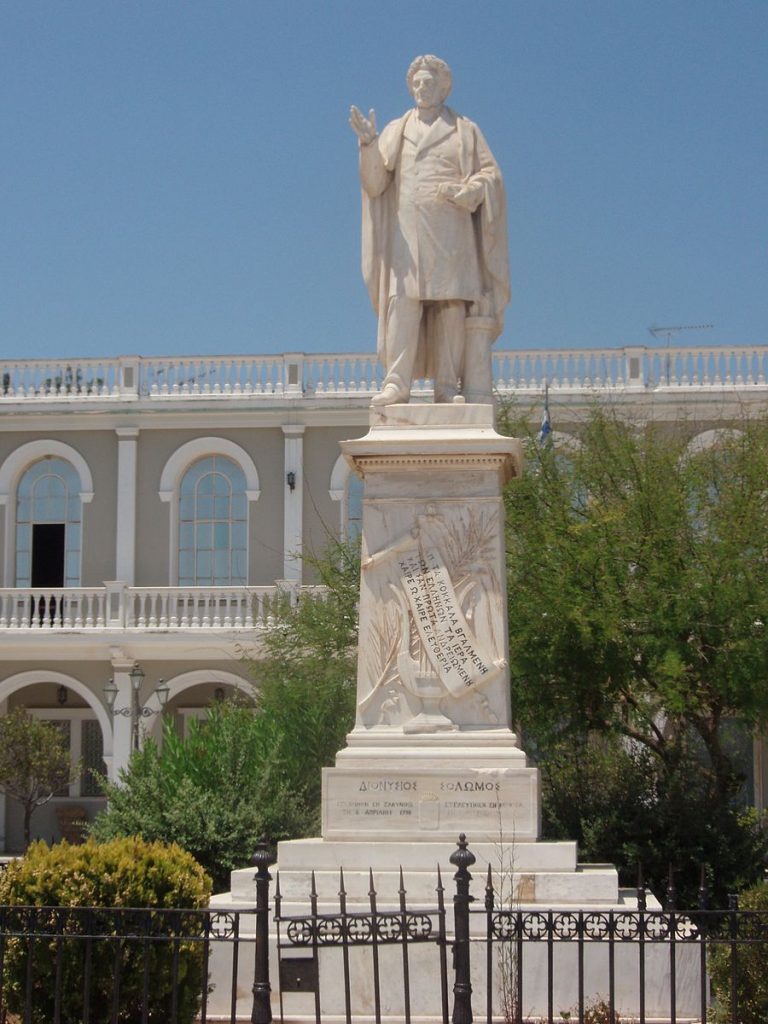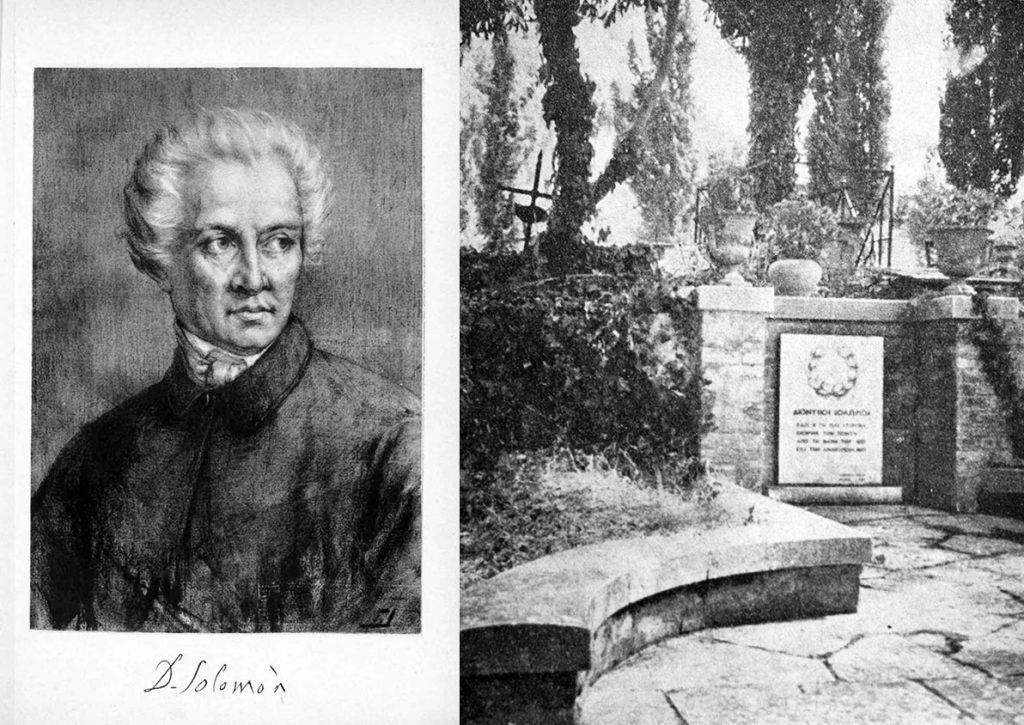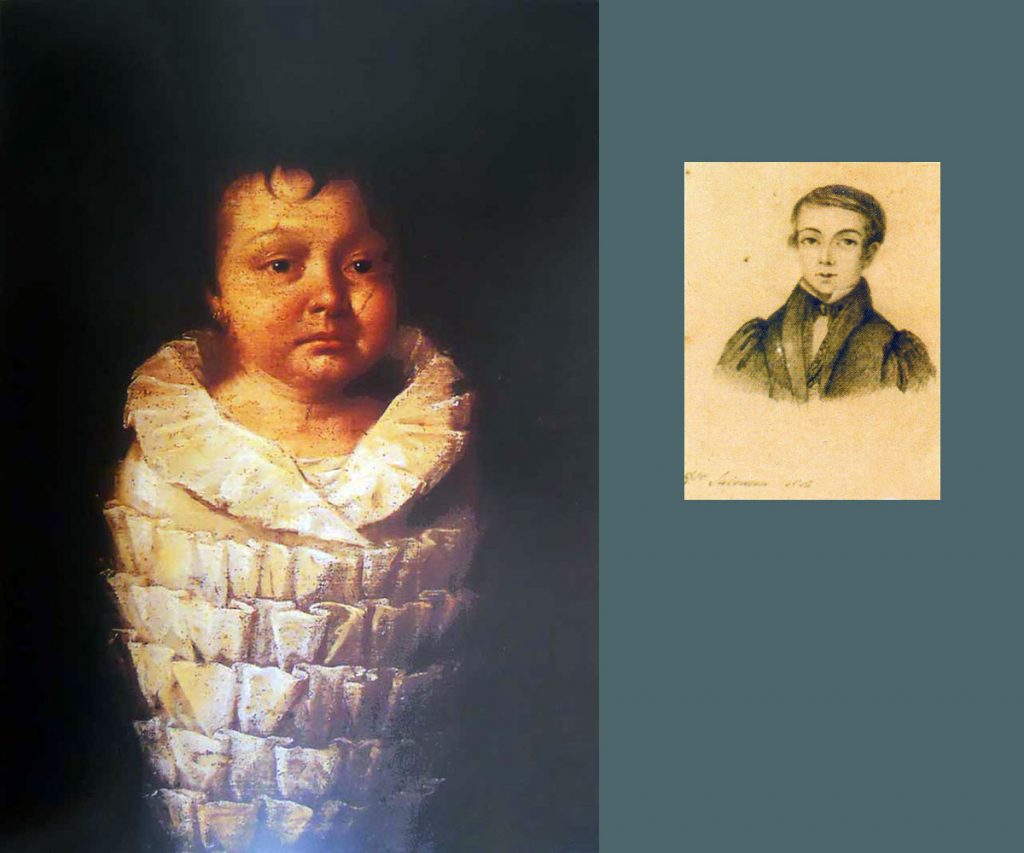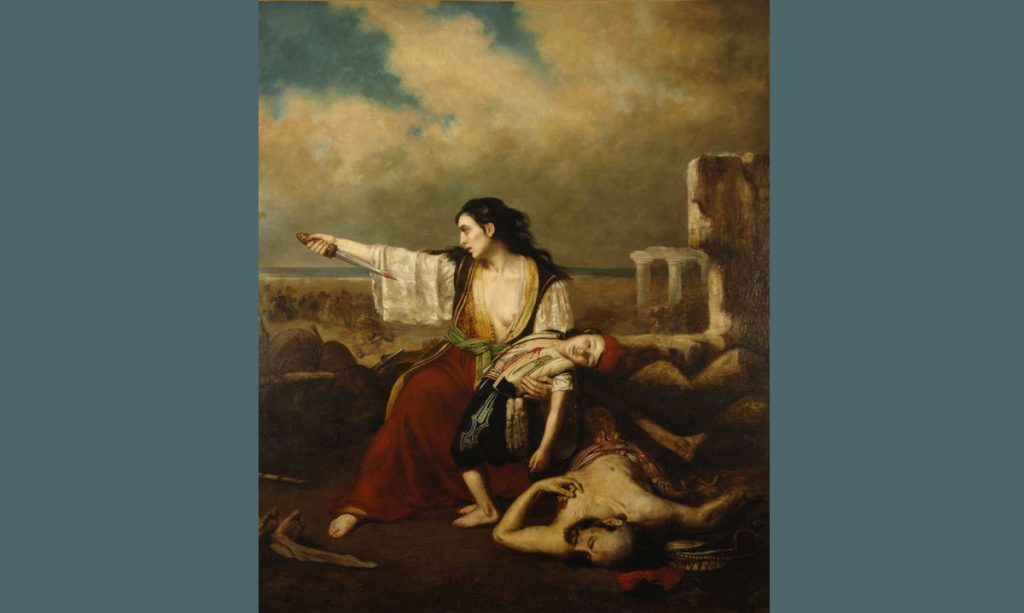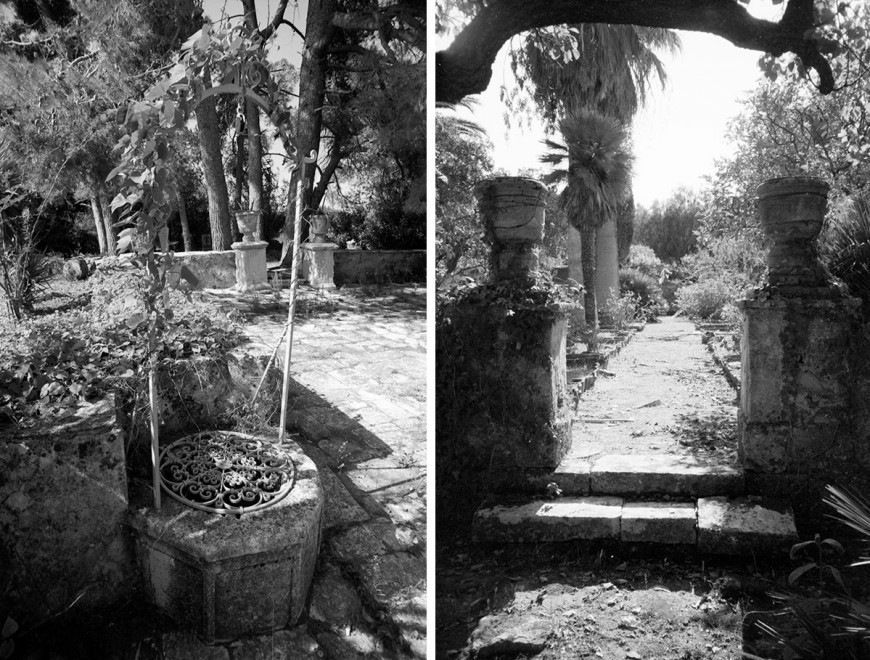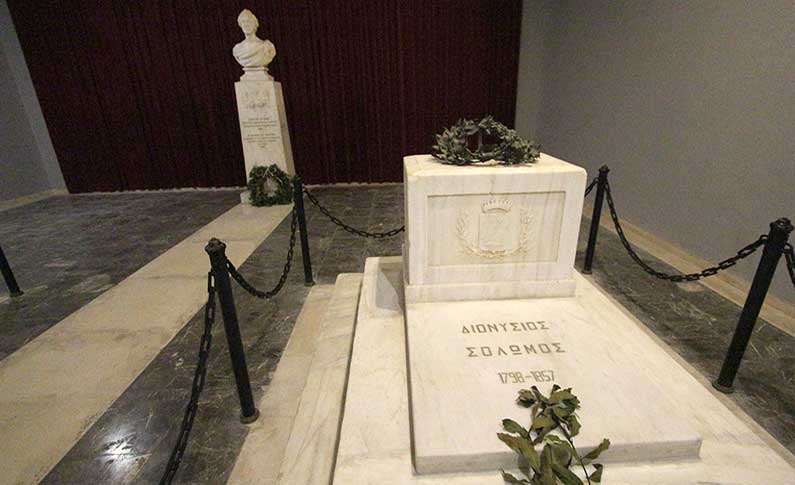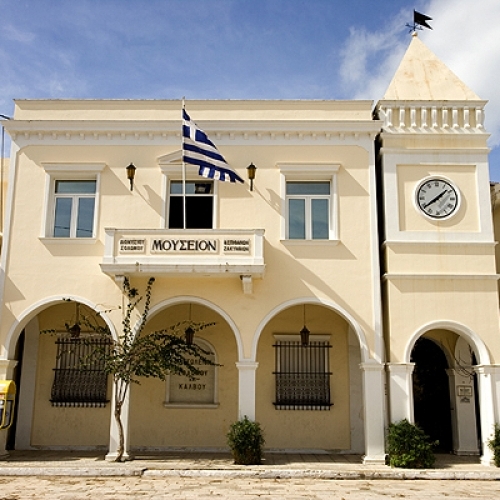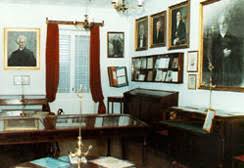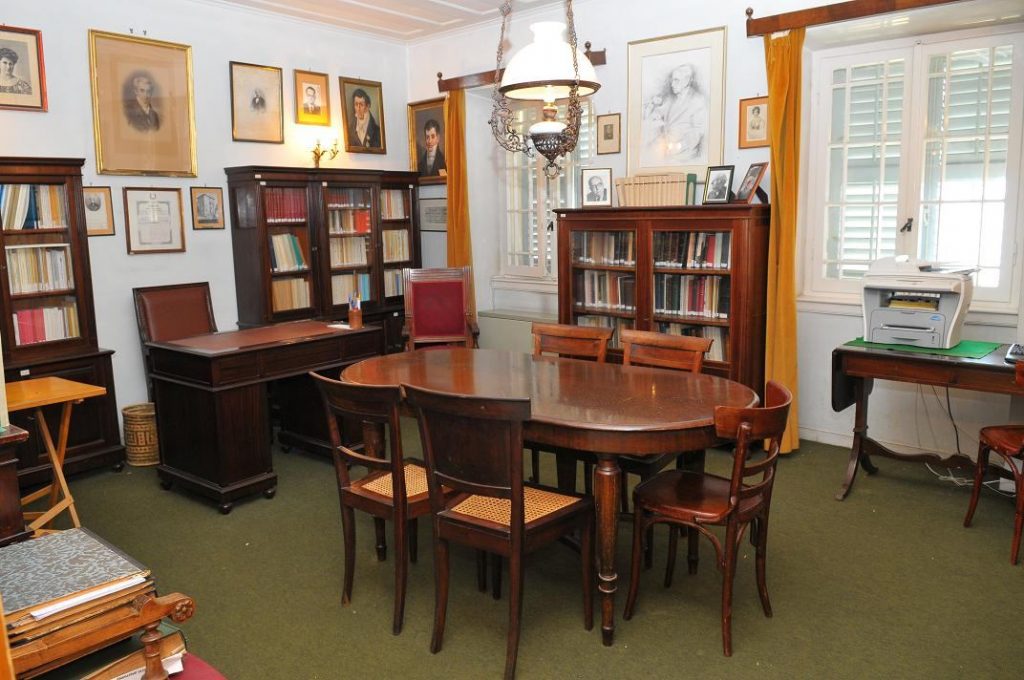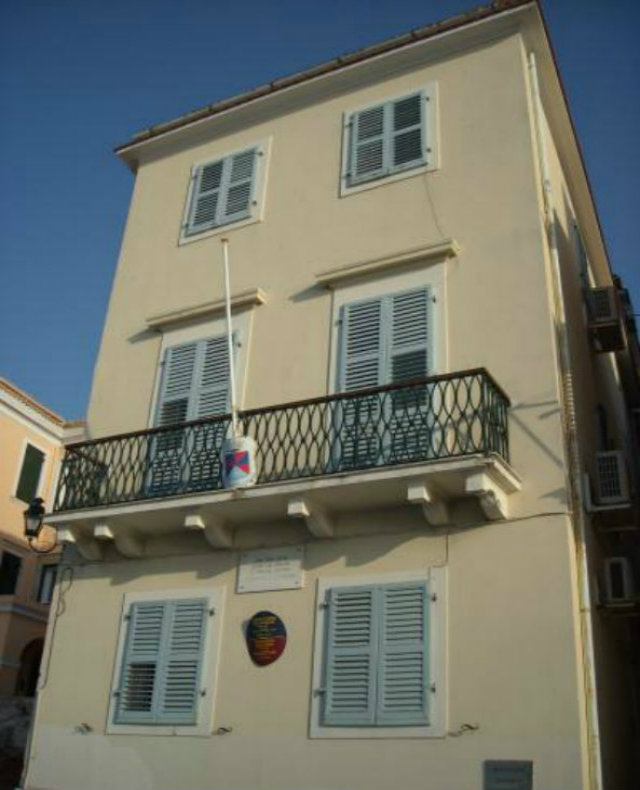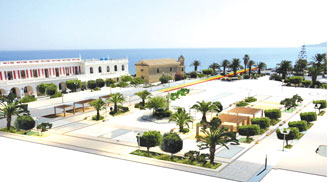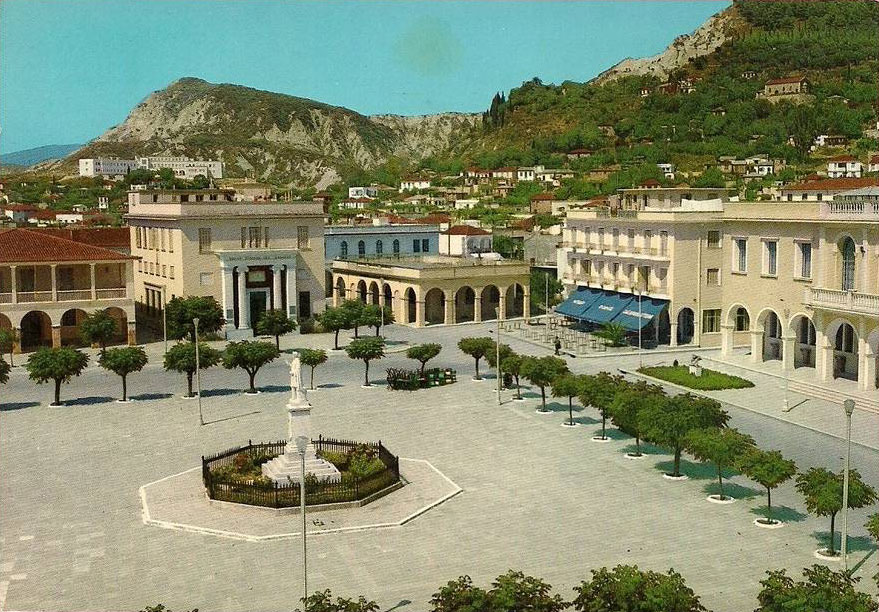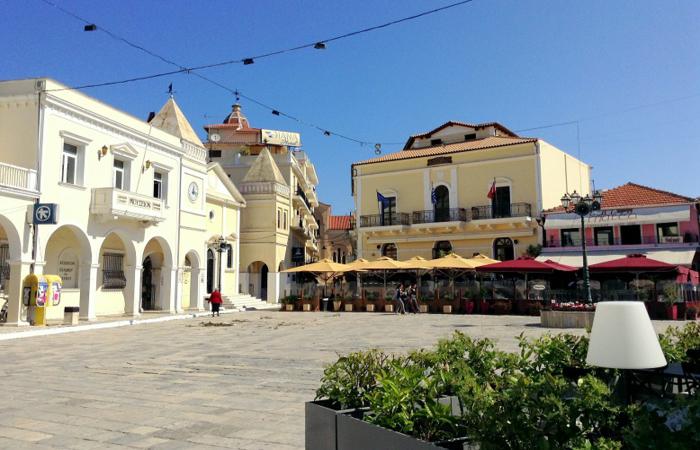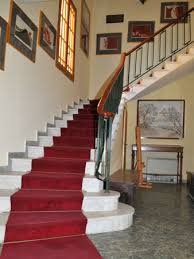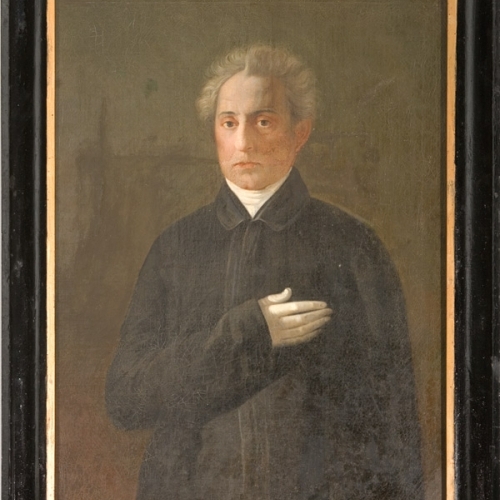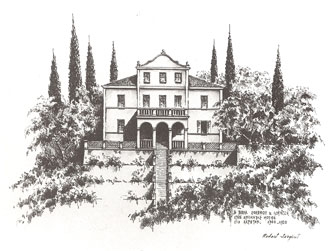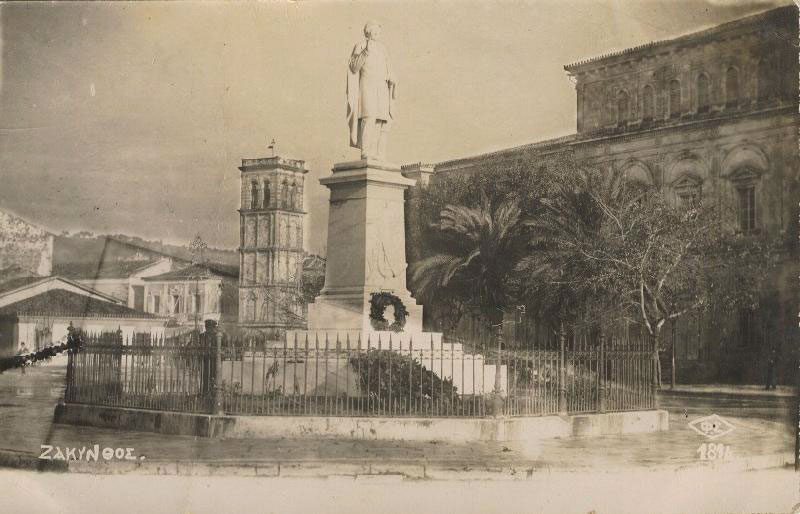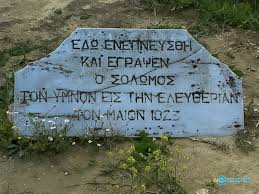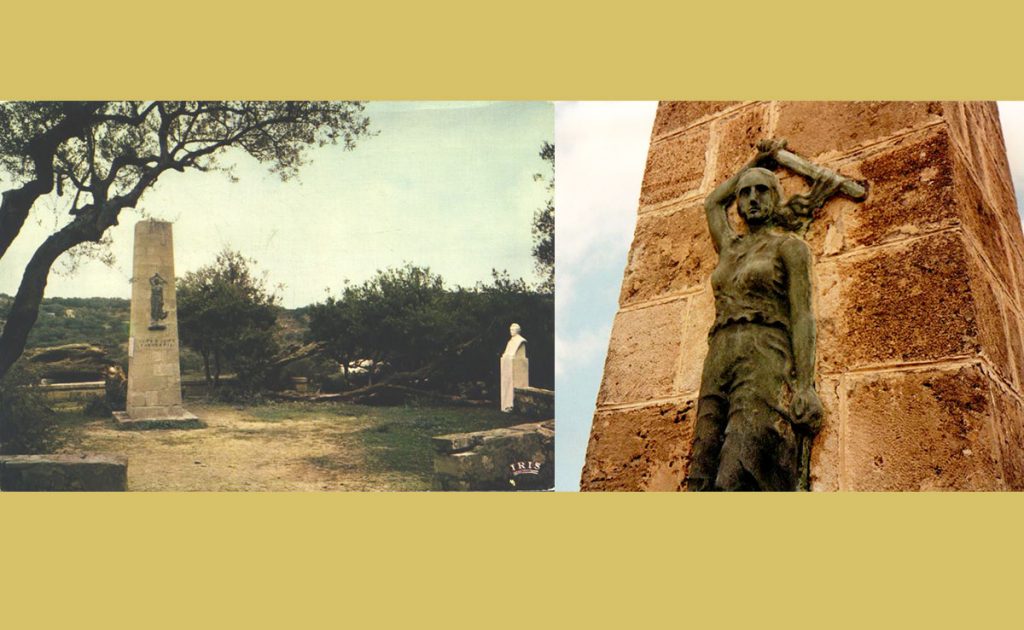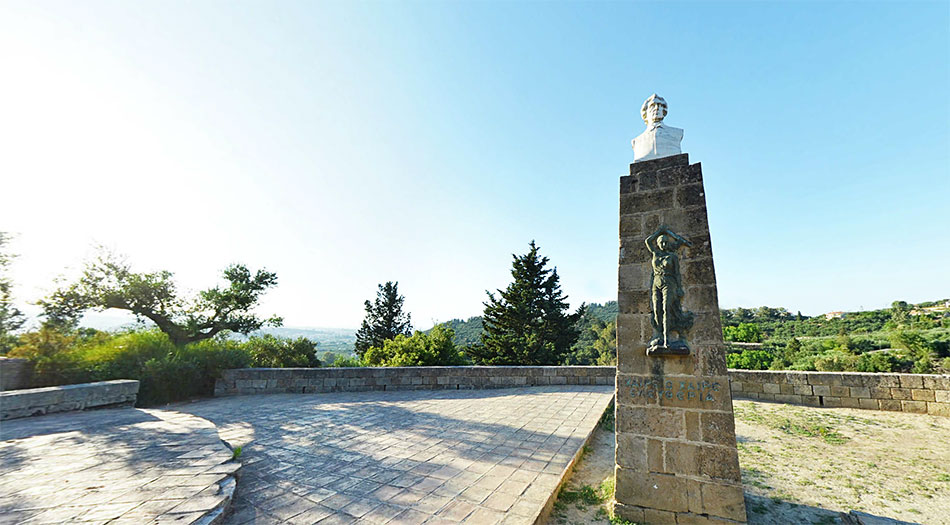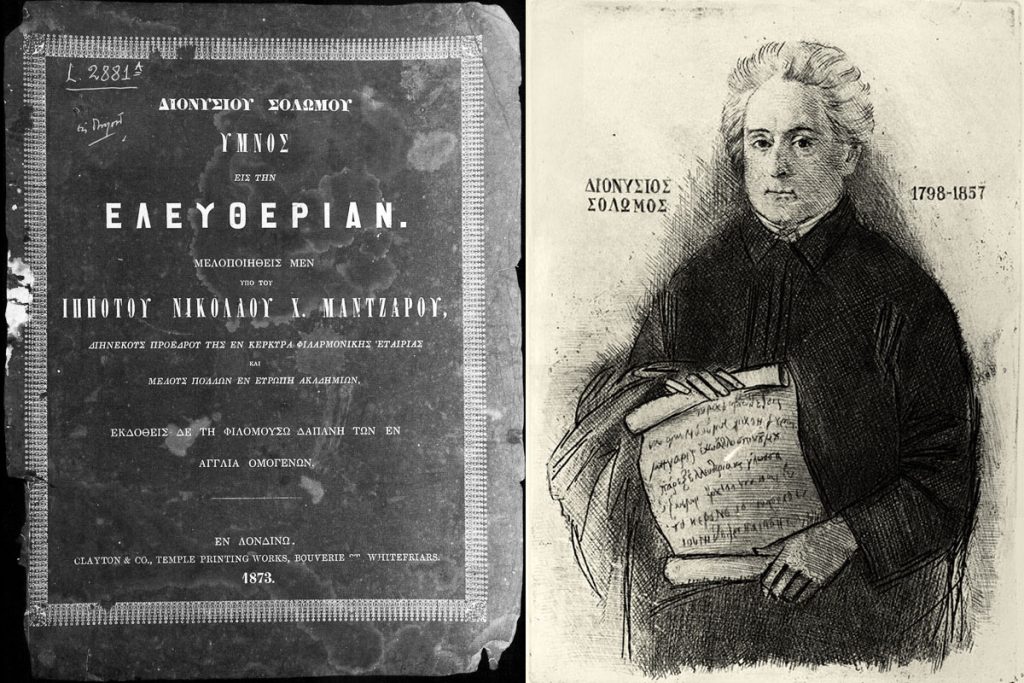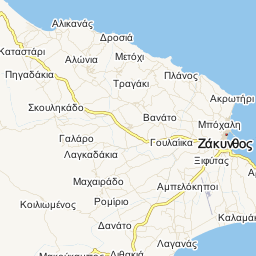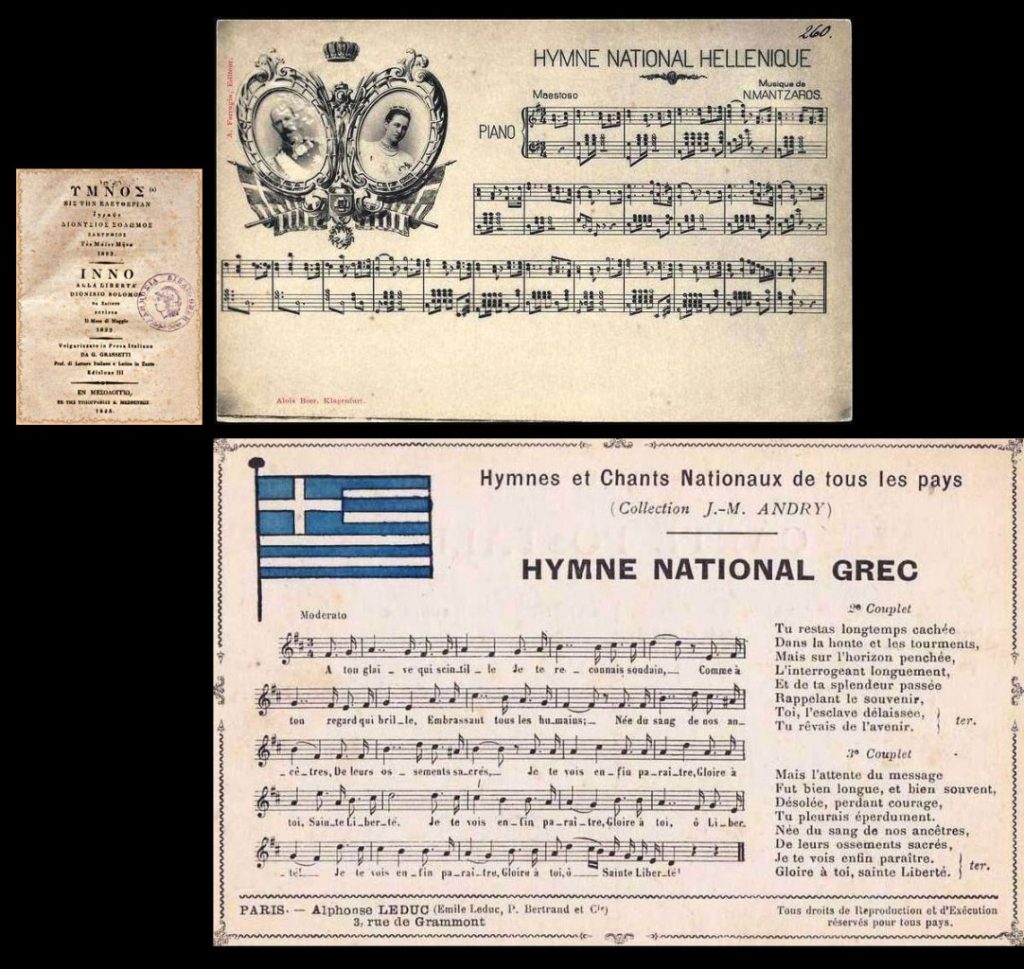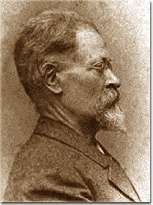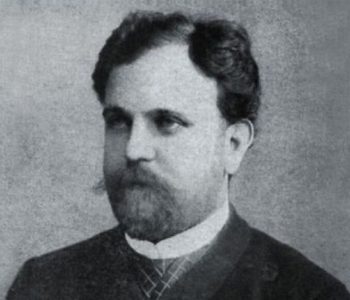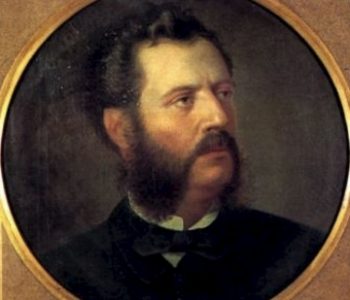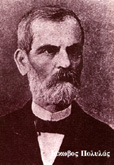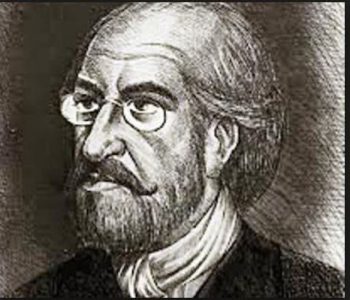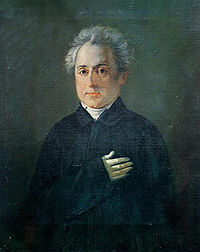
Author: Solomos, Dionysios Solomos
Date of Birth: April 8, 1798, Zakynthos Island
Gender: Male
Biography: Dionysios Solomos was born on April 8th, 1798, in Zakynthos. His father Count Nikolaos Solomos was the son of Cretan refugees and his mother Angeliki Nikli had origins in Mani. Count Nikolaos Solomos was legally married to Marnetta Kakni, who died in 1802.
From that marriage, he had two children: Roberto and Elena. Since 1796, Nikolaos Solomos had a parallel relationship with his housekeeper Angeliki Nikli, who gave birth to one more son apart from Dionysios, Dimitrios, later President of the Ionian Parliament. His father married Dionysios mother a day before he died on 27 February 1807, making the young Dionysios legitimate and a co-heir to the count’s estate, along with his half-brother. After the death of Solomos’ s father, Count Dionysios Messalas gained his custody, following the supervision period of his Italian tutor, Abbot Santo Rossi, and sent Solomos to Italy to continue his studies. He was enrolled at the Lyceum of St. Catherine in Venice, but he had adjustment difficulties because of the school’s strict discipline, forcing Rossi to take Solomos with him to Cremona, where he finished his high-school studies. By the end of 1815, Solomos was enrolled at Pavia’s University’s Faculty of Law, from which he graduated two years later. Deeply influenced by the Italian literature and being a fluent speaker of Italian, he started writing poems in Italian. Shortly after the first attempts, his work was officially recognized and he started being fascinated by the French Enlightenment.
After returning to his homeland, Solomos acquainted himself with people interested in literature, which at that time was rapidly flourishing. During that period, he got the idea to gather demotic songs from all over Greece in order to study them and discover unknown material that would develop his own work. This was a difficult task for the young poet, since his skills in the Greek language were poor, but also because there did not exist any poetic works written in the demotic dialect that could have served as models.
He started studying methodically the demotic songs and the Cretan literature, and timidly made his first attempts to write in the Greek language. However, Solomos’s encounter with Spyridon Trikoupis in 1822 was a turning-point in his writing. When Trikoupis visited Zakynthos in 1822, invited by Lord Guilford, Solomos’s fame on the island was already widespread and Trikoupis wished to meet him. During their second meeting, Solomos read to him the Ode to the first mass. Impressed by Solomos’s poetic skills, Trikoupis stood silent for a moment and then stated: “Your poetic aptitude reserves for you a select place on the Italian Parnassus. But the first places there are already taken. The Greek Parnassus does not yet have its Dante”. Actually, Trikoupis was the man who helped Solomos in developing his skills in the Greek language.
Image Gallery
Hymn to Liberty
It is widely claimed that a poet has to compose several works and poetry collections before gaining recognition. However, this wasn’t the case with Solomos. In May 1823, he completed the “Hymn to Liberty”, inspired by the 1821 Greek Revolution. The poem was published in Greece in 1824 and also in Europe one year later. The reputation of Solomos was immediately spread throughout Greece and abroad.
In 1828, a controversy emerged between him and his brother Dimitrios over inheritance issues and Solomos relocated to Corfu. However, several people claimed that Solomos had been already planning to relocate to Zakynthos, seeking a more spiritual environment and seclusion to work on his poetry. In Corfu, he started studying the German romantic philosophy and poetry, reading the Italian translations of major writers’ works.
A few years later, during the period from 1833 to 1838, further dispute broke into his family. Having restored his relationship with his brother, he found himself go against his half-brother, from his mother’s side, Ioannis Leontarakis, who legally claimed part of their father’s property, arguing that he was also the son of Count Nikolaos Solomos, as his mother had been pregnant before his death. Despite the positive outcome for the both of them, the legal battle resulted to the alienation of Solomos from his mother, choosing at the same time to distance himself from any form of publicity. However, he continued his writing work and expressed himself through his poems “The Cretan”, “The Free Besieged”, “The Whale”, which are his best works according to many. In 1849, Solomos was awarded the Gold Cross of the Redeemer.
The end of Dionysios Solomos was inglorious. In 1851, he suffered from serious health issues and stopped going out of his home following his third stroke in 1856. He died in February 1857. The news about his death were immediately spread throughout the country, which mourned him with honors.
Selected literature
Chronology of Dionysios Solomos
| 1798 | Birth in Zakynthos (April 8). His father was the son of Nicholas Solomos and his mother was Angeliki Nikli, a servant at the home of Count. From their love affair will be born in 1802 his brother, Dimitrios. |
| 1807 | Marriage of his parents. Death of his father. Second marriage of his mother. Birth of his half-brother, Ioannis Leondarakis. |
| 1808 | Departure for Italy, accompanied by Abbot Santo Rossi. He enrolls at the Lyceum of St. Catherine in Venice. |
| 1809 | He stays in Cremona, near Abbot Santo Rossi, and attends the High School of Cremona (-1815). |
| 1815 | He is enrolled at the University of Pavia where he attends law courses. First poems in Italian (“La Distruzione di Gerusalemme”) and until 1818 “Ode per prima messa”, two sonnets on the same subject, and the sonnets “In lode d’un fabbricatore d’organi” and “Per Nozze”. |
| 1817 | Takes the degree of Dokimos from the Law School of Pavia. |
| 1818 | He returns to Zakynthos. He begins to compose his first Greek language exercises and improvisations. At the same time, he writes in Italian improvised poems. |
| 1820 | He writes the sonnet “Alla Sra Stella Macri”. |
| 1821 | He co-authored a report to the King of England on the revision of the Constitution of 1817. He composes the poems (-1822)”The Two Brothers, “The Crazy Mother,” “Homer’s Shadow,” “Ode to the Moon,” “Eyricomis “,” The Unknowable “,” Xanthoula “,” Psychoula “. At the same time, he continues to write Italian-language improvised poems and composes the sonnet of “Preghiera al Santo Dionisio”. Dimitrios Solomos marries Elena Arvanitaki. |
| 1822 | The Italian-language collection of improvised poems Rime Improvvisate is published in Corfu. Acquaintance with Spyridon Trikoupis. |
| 1823 | He composes The Hymn to Liberty and starts the ode “On Marko Botsaris” (-1824). He writes the sonnet “Sulla morte di Pio VII”. Second edition of Rime Improvvisate (Corfu). The daughter of Dimitrios Solomos Annetta is born. |
| 1824 | He writes the text Dialog for the Greek language, the poems To the death of Lord Byron (1st processing -1825), Lampros (1st processing -1826), “To Lord George de Rossi” and “A Lord Guilford” (?) and three multilingual satirical poems directed by the doctor Dionysios Roidis (“Vizita”, “The Medical Board”, “New Year”).The stanza 151-158 of the Hymn to Liberty are published in the newspaper Literary Gazzette of London (11 Sept.), with English translation by G. Lee. Negative criticism of the collection Rime Improvvisate by his old friend, Giuseppe Montani, in the Italian journal Antologia and by Francesco Scalfi in the Revue Encyclopedique. |
| 1825 | The second volume of Greek demotic songs by Claude Fauriel, which was released in Paris in December 1824 but dates back to 1825, includes the Hymn to Liberty in a French translation by Stanislas Julien. The volume is translated into English by the philhellene Charles Brinsley Sheridan. The Hymn to Liberty is also printed in Messolonghi, with an Italian translation by Gaetano Grassetti, in collaboration with the poet. Positive criticism by Spyros Trikoupis in the General Gazette of Greece and by George Psyllas in the Athens Newspaper. He writes the epigram “The Destruction of Psara”. |
| 1826 | Birth of Angelica, daughter of Dimitrios Solomos. She is baptized by the poet. He writes the lyrical poem “Pharmakomeni”, on the occasion of the suicide of Marieta Papageorgopoulos and the satirical “Dream” against John Martinegko. He begins to write the satirical text Woman of Zakythos (1st processing – December 1829). |
| 1827 | He writes “Dead Ode I” for Spyridon Solomos, son of Solomos’s half-brother, Roberto. He continues his work on “The death of the Lord Byron” (2nd possessing -1829) and he recites the poem of “Elogio di Ugo Foscolo” in the Catholic church of St. Markus in Zakynthos. |
| 1828 | Distribution of paternal property between Dionysios and Dimitrios and court disputes. Permanent establishment in Corfu (late December). |
| 1829 | Loutzis begins translating for Solomos texts of German philosophy and poetry. He is acquainted with musician Nikolaos Mantzaros. He prints on the one-fold the ode “To the Nun” and processes the “Dead Ode II” and the “Prophecy to the Fall of the Messolonghi” (the so-called A’ Sxediasma of The Free Besieged Women of Zakythos) (-November 1833). |
| 1831 | Travel to Zakynthos. Reconciliation with his brother, Dimitrios. |
| 1832 | Death of the half-brother of Roberto Solomou, first-born son of Nikolaos Solomos from his first marriage and his only legitimate heir according to the current law until 1841. |
| 1833 | Initiation of family trial: Dionysios and Dimitrios’s struggle with Ioannis Leondarakis. Poetic expansion with the third processing of Woman of Zakythos and a series of satirical poems. He designs a vertebrate, eight-dimensional poetic composition with 4 lyrical and 4 satirical parts, the so-called Composition 1833-1834, and for this purpose he processes the “The Tricha”, “The Cretan” (1834), “The Pharmakomeni in Hades”, the already published “The vision of Lampros” (from Lampros) and he designs the “The Prisoner”, “The Displacement of the Metland’ s Statue”, “Second Dream”. |
| 1834 | The Free Besieged (B’ Sxediasma -1844); A piece from “Lampros” ( No. 25) is published in the Ionian Anthology. |
| 1835 | New Testament: General heir is his brother, Dimitrios. |
| 1836 | Trip to Zakynthos in September (where he will stay for 9 months). The first court order of the “family trial”, favorable to Dionysios and Dimitrios. |
| 1837 | Return to Corfu in Mai. The second court decision on “family trial”, favorable to Dionysios and Dimitrios. |
| 1838 | The decision of the Supreme Council of Justice, also favorable to Dionysios and Dimitrios. The Parliament recognizes the title of the Count. Dimitrios settled in Zakynthos where he would be elected member of the parliament (1839). |
| 1842 | He is acquainted with Iakovos Polylas. |
| 1843 | Marriage of Annetta Solomou, daughter of Dimitrios, with his friend, the poet Nikolaos Loutzis. |
| 1844 | The Free Besieged (Γ΄ Sxediasma -1851?). N. Mantzaros put music in the Hymn, it is dedicated to King Othon by Solomos. “Nikiphoros the Vryennius” (1844 / 47-51). |
| 1845 | Dimitrios is appointed Commander of Zakynthos. |
| 1846 | He writes the sxediasma “La donna velata” (for the wife of Gaetano Grassetti, Adelaide Karvela). |
| 1847 | He began processing the “Porphyra” (-1849) on the occasion of the murderous shark attack on the English soldier William Mills. Return to Italian-language lyrics (-1851, with the poems “Saffo”, “L’albero mistico”, “La Madre Greca”, “L’Usignolo e lo Sparviere”, etc.). He recites the sonata “Orfeo” at the theater of Corfu. |
| 1848 | “To the death of Emilia Rodostamo” (Emilia Rodostamo). |
| 1849 | He is decorated from the King Othon with the Golden Cross of the Savior. It processes the “Carmen Seculare / The Secret Tree” and prints the epigram “In Fragiska Fraiser”. He writes the satirical “Το Megistana” against George Komotos. Publication of 15 solo poems in the newspaper Aion. |
| 1850 | Dimitrios Solomos is appointed by the Chancellor President of the Senate. Solomos writes the poem “To the death of his niece”, “To the King of Greece while he was passing through the waters of Corfu”, “For the death of English Lady”. Meeting with Spyros Trikoupis. |
| 1851 | He is acquainted with Corfu’s Italian improviser Giuseppe Regladi, who will become his first biographer. He recites the Italian-speaking poem “La Navicella Greca” to the Ionian Academy. First stroke. Dimitrios Solomos resigns from Senate President. |
| 1852 | He writes the “Sonetto in morte di Stelio Marcoran”. |
| 1853 | He is elected a member of the Corfu Reading Society. Publication of poems in the journal Efterpi. Emmanuel Stais publishes the study Kritiki. Lampros of Solomos (Athens). Georgios Kandionos Romas dedicates to Solomos his poetic collection Flowers (Corfu). Solomos writes the epigram “Ad Alice Ward”, for the daughter of the Commissioner. The Grammatica della lingua Greca Moderna (Malta) of Gaetano Grassetti is published after his death, including exterpts from Lampros. |
| 1854 | He writes the sxediasma of the “Eastern War”. New stroke. Epigram “Al Signore Cavaliere Giovanni Fraser”, for the departure of the former secretary of the Commissioner. |
| 1855 | Published in Efterpi magazine, the poet’s translation of the poem “Metastasio”[In a harsh sea I run …]”. He contributes a considerable amount to the victims of cholera in Corfu. |
| 1856 | The ode “To the Nun” is published under the title “The rasoforomeno korasio” in the magazine Thelksinoi (1856). After a new serious stroke, he will remain bedridden until his death. |
| 1857 | “Pharmakomeni”, a poem that had been published altered in anthologies under various titles as the poet lived, is published in a form approved by Solomos in Pandora Magazine (1.2.1857) entitled “The Pharmakeumeni kori”. On 9/27 February Solomos dies in Corfu. The Parliament interrupts its work and declares public mourning. The collective volumes are printed with the title Collection of the famous poems of the Count Dionysiou Kom. Solomou (Issue of Rusolimou, Zakynthos) and Solomos Poems and Ode to his death (Athens, digitized version). |
| 1859 | The death of his mother. In October, Dionysios Solomos, The Eyriskomena is published with the editing and “Prolegomena” by Iakovos Polylas (Zakynthos, Hermes print by Antonius Terzakis) (digitized version). Spyridon Zambelios publishes the study of Pothen the common word sing. Thoughts on Greek poetry (Athens, digitized version), where he chooses the youthful work of Solomos and rejects the mature. |
Poems
